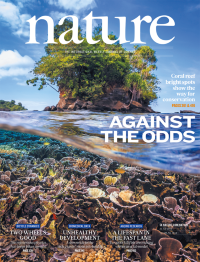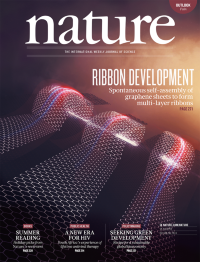Volume 535
-
No. 7613 28 July 2016
In Western cultures, some combinations of musical notes are perceived as pleasant, or consonant, and others as unpleasant, or dissonant. The cover shows superimposed frequency spectra of two musical intervals, one consonant (the perfect fifth) and one dissonant (the tritone). The composite frequency spectrum of the consonant interval forms a subset of the harmonic series (integer multiples of a common fundamental frequency, indicated by the black line segments). By contrast, the frequency spectrum of the dissonant interval is inharmonic. The aesthetic contrast between consonance and dissonance is commonly thought to be biologically determined and thus to be universally present in humans. Josh McDermott and colleagues put this idea to the test by conducting experiments in remote areas of the Bolivian Amazon rainforest, working with the Tsimane�, an indigenous society that has remained relatively isolated from Western culture. They found that the Tsimane� rated consonant and dissonant chords and vocal harmonies as equally pleasant. By contrast, Bolivian city- and town-dwellers preferred consonance, albeit to a lesser degree than US residents. These findings suggest that the preference for consonance over dissonance is not universal, and probably develops from exposure to particular types of polyphonic music.
-
No. 7612 21 July 2016
A coral reef surrounding a small island in Kimbe Bay, Papua New Guinea. The health of the worlds coral reefs, which provide goods and services for millions of people, is declining. Effective management of these ecosystems requires an understanding of the underlying drivers of reef decline. In a study that spans the gap between ecology and the social sciences, Joshua Cinner and colleagues develop a Bayesian hierarchical model, using data from more than 2,500 reefs worldwide, to predict reef fish biomass based on various socioeconomic drivers and environmental conditions. They identify 15 bright spots � sites where reef biomass is significantly higher than expected. The bright spots are found not only among iconic remote and pristine areas, but also where there are strong sociocultural institutions and high levels of local engagement. On the basis of this analysis, the authors argue for a refocus of coral reef conservation efforts away from locating and protecting remote, pristine sites, towards unlocking potential solutions from sites that have successfully confronted the coral reef crisis. Cover photo by Tane Sinclair-Taylor (t.sinclairtaylor@gmail.com)
-
No. 7611 14 July 2016
The cover illustrates parallel self-assembly of three ribbons from a single-layer host graphene sheet. More than twenty years ago it was envisioned that graphene could be folded and cut into useful forms as a kind of nanoscale origami. In this issue James Annett and Graham Cross describe a system in which single-layer graphene can reorganize itself into three dimensions by a process of folding, sliding and tearing. When a small flap of graphene sheet is folded over to touch itself, it spontaneously starts to slide, tearing into a ribbon-like strip in the process. On removal of a kinetic barrier, the two-dimensional material can coalesce into its more familiar three-dimensional, layered form. The driver for this peeling phenomenon is a thermodynamic mechanism that is robust enough to work over large areas even in air at room temperature. The findings hold promise as a novel mechanism to mechanically actuate two-dimensional materials as well as a new way of assembling them into complex three-dimensional architectures. Cover: Domhnall Malone
-
No. 7610 7 July 2016
Viscosity field and surface of a convection model of Earth: low viscosity zones in red are plate boundaries and high viscosity zones in dark blue are continents. The interior shows hotspots in red and subduction zones blue. The subsurface layers of Earth appear as an interlocking network of tectonic or lithospheric plates of various sizes and shapes. The nature of the link between mantle flow and tectonics, and the origin of the layout of the plates remain largely unknown. Claire Mallard et al. have developed computer models of mantle convection with plate-like behaviour and use them to produce a series of virtual Earths� that project the network of plate boundaries through time. The models suggest that the layout of large plates is controlled by the spacing between subducting slabs, and that stresses caused by the bending of trenches break plates into smaller fragments, explaining why rapid evolution in small back-arc plates reflects the dramatic changes in plate motions during times of major plate-tectonic reorganizations. Cover C. Mallard et al.




